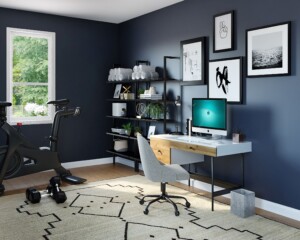 Looking at the bookcase in my dining room, I got inspired to write an article about rooms that are used for more than one purpose. Recently downsizing into a smaller home, there really was no other place in the house for my bookcase besides the dining room. The size of other rooms, location for doors, closets and windows (as well as the function of the room) would have made the beloved bookcase overbearing or awkward in any other location. I then began to feel better when I searched the internet, to find many gorgeous examples of bookcases in dining rooms.
Looking at the bookcase in my dining room, I got inspired to write an article about rooms that are used for more than one purpose. Recently downsizing into a smaller home, there really was no other place in the house for my bookcase besides the dining room. The size of other rooms, location for doors, closets and windows (as well as the function of the room) would have made the beloved bookcase overbearing or awkward in any other location. I then began to feel better when I searched the internet, to find many gorgeous examples of bookcases in dining rooms.
From the stand point of Yin Yang theory, the ideal is to have a separate space for each activity. We don’t normally want to see a contradiction of activities or intentions if possible. For years, I have noted that it can be a conflict of interest to have a home office in a bedroom. Why? Well, everything about the bedroom should signal rest and relaxation. However, the home office (with desk, computer, file cabinets) can be overly stimulating and counter-productive. In reverse, a home office in a bedroom could make us sleepy.
And yet, many people do not have the luxury for separate spaces. Is it bad that my “Cat Room” with her cat condo and feeding station are in the same room as my stationary bike and far infrared sauna? Is it bad that I have an altar and meditation spot in my guest bedroom?
With my informal dining room being part of a large kitchen, it would appear to not be a conflict at all since the preparation of food goes right along with the consumption of it, even when entertaining guests. But other combinations of activities might be more questionable.

Now, the person who lives in a studio apartment has been dealing with this issue all along. The couch may become a roll out bed at night and every activity takes place in the same room, except for the bathroom. Sometimes people unwittingly clutter up their studio apartment with furnishings meant to create faux walls and separation of activity spaces. To do that, and to signal a separate space, the back of a couch could be the demarcation line for one space, without having to place a row of plants or something which could make a room look choppy and smaller than it actually is. There are YouTube designers and space planners who show viewers how to make a small space appear bigger than it is. This is a priority for a small space, regardless of the number of activity spots one has.
To sum it all up, you can have combination rooms without concern most of the time, especially if you live alone or don’t have a partner or house mate trying to do something contradictory in a room you share. It goes without saying that if you are trying to sleep in the bedroom and your partner is one the phone or a computer in the corner: that is a recipe for tension and problems. Even if they are quiet, the glow of a lap top screen could upset the other person’s sleep cycle.
Another common Combination Room is the Home Office that also has a bed for the occasional guest. This is not a problem since the host will likely forfeit the use of the home office while the guest is using the room.
As long as you have the space adjusted with the ideal colors and elements, any activity or a combination of activities can be experienced in one room. And as long as it does not become a clutter-fest, blocking light, ventilation and easy access, then it should be perfectly fine to have a combination den and exercise room, or a combination meditation and craft room, just as a few examples.
Author: Kartar Diamond
Company: Feng Shui Solutions ®
From the Architecture & Design Blog Series
